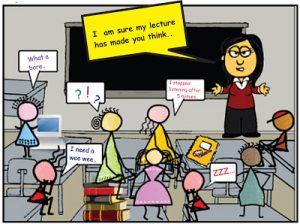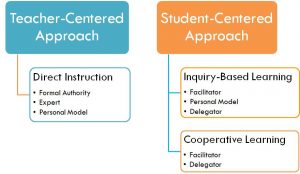In this age of network development, people can gain knowledge through many resources and channels. I don’t know when the relationship between the teacher and the student has gradually changed. In this article called “Basic Philosophies of Distributed and Open Learning,” I read some fascinating ideas and concepts I haven’t heard. There are three aspects that I want to publish in this blog: some ideas for students and teacher-centred learning, asynchronous and synchronous learning, and Connectivism.
In the era when the Internet was not very developed, teachers considered to be the sacred profession of “sages on the stage” by all learners. At that time, teachers were naturally the best way for us to acquire knowledge, but perhaps not the only way. No doubt, the teacher was the center of the class at that time. Slowly due to the development of the Internet, more and more online courses are getting better and better. At this time, the identity of the teacher has gradually changed. They are no longer just people who pass on the knowledge in our textbooks, but show how to control the overall direction of our learning and guide us on how to achieve “self-directed learning.” I have a deep understanding of this significant change. As an international student from China, I genuinely feel the difference in instructional design between China and Canada.
When I was in China, the teacher was a “sage on the stage.” We have never developed a sense of self-directed learning, but have relied entirely on our teachers to impart knowledge to us. Students are not allowed to bring mobile phones and electronic devices in the school. All of our learning steps follow the teacher. Teachers in China have high majesty and are the center of the curriculum.

When I first came to Canada, I was not used to the difference. I couldn’t learn independently. I always rely on teachers to teach me all aspects of knowledge. When I first registered for an online course, I was stunned about the design of this course. In this class, learners need to learn independently, to start their weekly study and complete the homework of that week at each period. Taking an online course is a very novel experience for me, and I feel it has improved my learning ability. I am a very poor learner in China, but the online courses and self-directed learning design in Canada forced me to plan my own time and to study by myself. Gradually, my learning ability gets significant improvements. That is all due to a substantial shift in teacher rights and control dynamics in online courses.
The second interesting new concept is asynchronous learning and synchronous learning. In most schools, the courses that need to conduct with teachers during the course called synchronous learning, while online classes on the Internet are called asynchronous learning. I think everyone has their preferred method. I prefer asynchronous learning. In asynchronous learning, everyone can adjust the learning progress according to their understanding ability, instead of not missing the teacher’s content every minute like in synchronous lessons. I think it will make me very nervous in the synchronous course. When I miss a little bit of the content of the teacher, I will fall behind the whole class. Asynchronous courses do not require everyone to have the same progress. Everyone can enter at different times and complete assignments at different times. There is no time limit in asynchronous courses. If you want, you can browse the course content countless times late at night or early in the morning. This course design not only meets the needs of students but also meets the needs of office workers, who can also acquire knowledge after work. Of course, I am not saying that asynchronous classes are 100% good.

For example, some people may lack the ability to learn and manage themselves. They may have severe delays that prevent them from completing assignments and learning within the time frame specified in the asynchronous course. There was a case that happened to my friend who had missed online exams and duties due to severe delays. Simultaneous learning also has its advantages. We may have our misunderstandings when learning autonomously. In synchronous learning, the teacher tells the correct knowledge to help us understand. A conclusion of mine is a mixture of synchronous and asynchronous learning is the best, totally depending on how the company or teacher designs the course.
There are many different learning theories for the digital age, and a critical one is Connectivism. There is no doubt that if we know how to use this theory correctly, our learning ability will be significantly improved.
In short, Connectivism means that you can obtain the knowledge you need through various resources on the Internet, and then you can share the new information you have learned with others. In my understanding, a vast network of relationships has formed between you, and this information will circulate in this network of contacts. I think the advantages of Connectivism outweigh the disadvantages. The power is that when I can’t clearly understand what the teacher tells in class, I have other resources that I can rely on to find the right information. And on the Internet, we can obtain information from all over the world, and everyone’s opinions can be published online. But the shortcoming of Connectivism also happens to be here. How can we distinguish the correct information? For example, my grandma often saw blogs online to share knowledge about how to become healthier. She never doubted the accuracy of this information and believed it. Another example is my younger brother, who already knows how to scold others in the game because of developed Connectivism
For myself, I get more help from Connectivism than weaknesses in my daily life. I enjoy the process of learning from the master through these resources on the Internet. As long as we screen this information correctly, Connectivism is our best learning theory.
